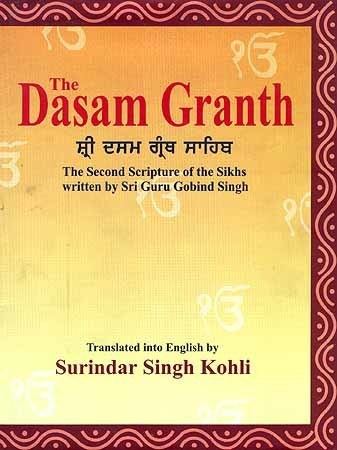 | ||
Similar Adi Granth, Japji Sahib, Zafarnamah, Anand Sahib, Mahan Kosh | ||
The Dasam Padishah ke Granth, commonly known as Dasam Granth (Gurmukhi: ਦਸਮ ਪਾਤਿਸ਼ਾਹ ਕੇ ਗ੍ਰੰਥ ਸਾਹਿਬ,ਦਸਮ ਗਰੰਥ ਸਾਹਿਬ), is a religious text containing many of the texts traditionally attributed to Guru Gobind Singh. It is written primarily in Braj Bhasha, with Awadhi, Hindustani, Punjabi and Persian compositions written almost entirely in the Gurmukhī alphabet except for the Fatehnama, Zafar Nama and Hikayat, which are in the Persian alphabet.
Contents
The Dasam Granth is a separate religious text from the Guru Granth Sahib.
Some compositions of the Dasam Granth such as Jaap Sahib, Tav-Prasad Savaiye and Benti Chaupai are part of the Nitnem or daily prayers and also part of the Amrit Sanchar or baptism ceremony.
Authorship
Although the compositions of the Dasam Granth are widely accepted to be penned by Guru Gobind Singh there are some that still question the authenticity of the Dasam Granth. There are three major views on the authorship of the Dasam Granth:
- The historical and traditional view is that the entire work was composed by Guru Gobind Singh himself.
- The entire collection was composed by the poets in the Guru's entourage.
- Only a part of the work was composed by the Guru, while the rest was composed by the other poets.
In his religious court at Anandpur Sahib, Guru Gobind Singh had employed 52 poets, who translated several classical texts into Braj Bhasha. Most of the writing compiled at Anandpur Sahib was lost while the Guru's camp was crossing the Sirsa river before the Battle of Chamkaur (1704). There were copiers available at Guru's place who made several copies of writings. Later, Bhai Mani Singh compiled all the available works under the title Dasam Granth.
The traditional scholars claim that all the works in Dasam Granth were composed by the Guru himself, on the basis of Bhai Mani Singh's letter.But the veracity of the letter has been examined by scholars and found to be unreliable. Any one even moderately acquainted with Hindi can tell from the internal evidence of style that Chandi Charitar and Bhagauti ki War are translations by different hands. Some others dispute the claim of the authorship, saying that some of the compositions included in Dasam Granth (such as Charitropakhyan) are "out of tune" with other Sikh scriptures, and must have been composed by other poets. The names of poets Raam, Shyam and Kaal appear repeatedly in the granth. References to Kavi Shyam can be seen in Mahan Kosh of Bhai Kahan Singh Nabha, under the entry 'Bawanja Kavi' and also in Kavi Santokh Singh's magnum opus Suraj Prakash Granth.
Historical writings
The following are historical books after the demise of Guru Gobind Singh which mention that the compositions in the present Dasam Granth was written by Guru Gobind Singh:
Structure
The length of the modern printed version of Dasam Granth is 1428 pages.
It contains the Jaap Sahib, the Akal Ustat or praise of the Creator and the Bachittar Natak, which gives an account of the Guru's parentage, his divine mission and the battles in which he had been engaged.
Next come three abridged compositions of the wars of Durga, called Chandi, with demons (Chandi Chritras: Chandi Chritra I, Chandi Chritra II, Chandi di Var).
Following this is the Gyan Parbodh, or awakening of knowledge; the Shabad Hazare; quatrains called savaiye (singular savaiya), which are hymns in praise of God and reprobation of idolatry and hypocrisy; the Shastar Nam Mala, a list of offensive and defensive weapons used in the Guru's time with special reference to the attributes of the Creator; the Kabiovach Bainti Chaupai, which will "absolve the suffering, pain or fear of the person, who will even once recite this Bani"; the Zafarnamah, containing the Tenth Guru's epistle to the emperor Aurangzeb; and hikayats, Persian language metrical tales.
Contents
These are the compositions included in Dasam Granth:
Some birs (recensions) also include the following compositions:
Role in Sikh liturgy
The compositions within Dasam Granth play a huge role in Sikh liturgy, which is prescribed by Sikh Rehat Maryada:
Chandi di Var is important prayer among Nihang Sikhs.
Compilation
Giani Gian Singh claims that the full copy of the Dasam Granth was in possession of the Budha Dal, an 18th-century Sikh army, at the Battle of Kup and was lost during the Second Sikh Holocaust (1762)
The earliest surviving full manuscript of the Dasam Granth dates to 1713, although it appears not to have been publicly available. In 1721, Mata Sundari commissioned Bhai Mani Singh with compiling a volume of the Dasam Granth. He completed his manuscript after collecting and sifting through material collected from a number of Sikhs. "Minor textual variation" exist between the early manuscripts. During the 1890s the text was standardized into its current two-volume 1,428 page print version.
